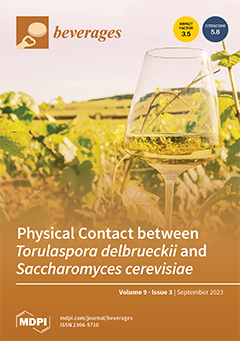The use of multi-starters in oenological conditions (
Saccharomyces cerevisiae and non-
Saccharomyces species) is becoming increasingly common. For the past ten years, the combination of
Torulaspora delbrueckii and
S. cerevisiae has been proposed to winemakers to improve the wine aromatic profile compared
[...] Read more.
The use of multi-starters in oenological conditions (
Saccharomyces cerevisiae and non-
Saccharomyces species) is becoming increasingly common. For the past ten years, the combination of
Torulaspora delbrueckii and
S. cerevisiae has been proposed to winemakers to improve the wine aromatic profile compared to pure inoculation with
Saccharomyces cerevisiae. In this work, two commercial strains,
T. delbrueckii Zymaflore
® Alpha and
S. cerevisiae Zymaflore
® X5 (Laffort compagny, Floirac, France), were investigated in Sauvignon blanc must using a fermentor with a double compartment allowing for physical separation of the two yeast species. The physical separation of the two species resulted in significant differences in the growth, fermentation kinetics (maximum fermentation rate (+13%)), fermentation duration (−14%) and the production of 3SH (+35%) in comparison to mixed cultures with contact. Proteomic analysis confirmed cell–cell contact interactions, as strong differences were observed for both species between mixed cultures with and without physical contact.
T. delbrueckii mortality in mixed cultures with physical contact may be explained by an oxidative stress. Indeed two proteins implicated in the oxidative stress response were found in significantly higher amounts: a cytosolic catalase T and a cytoplasmic thioredoxin isoenzyme. For
S. cerevisiae, an increase in proteins involved in the respiratory chain and proton transport were found in higher amounts in pure cultures and mixed culture without physical contact. Our results confirmed that the two mixed inoculations increased certain minor esters (ethylpropanoate, ethyl dihydrocinnamate and ethyl isobutanoate) specifically produced by
T. delbrueckii, 3.4-fold more compared to in the pure
S. cerevisiae culture. In conclusion, these results provide new insights into the underlying mechanisms involved in cell–cell contact and confirm the benefits of using
T. delbrueckii species under winemaking conditions.
Full article





